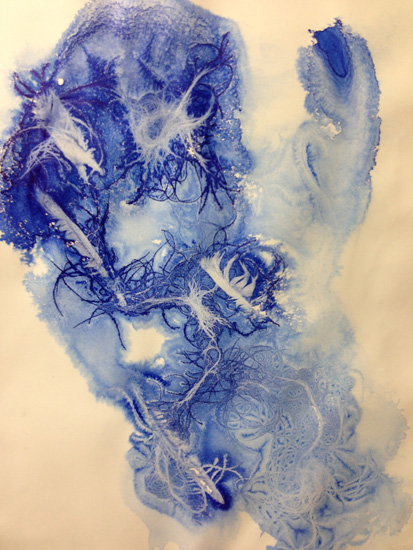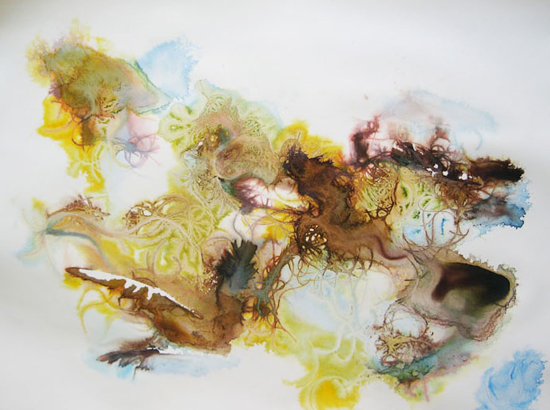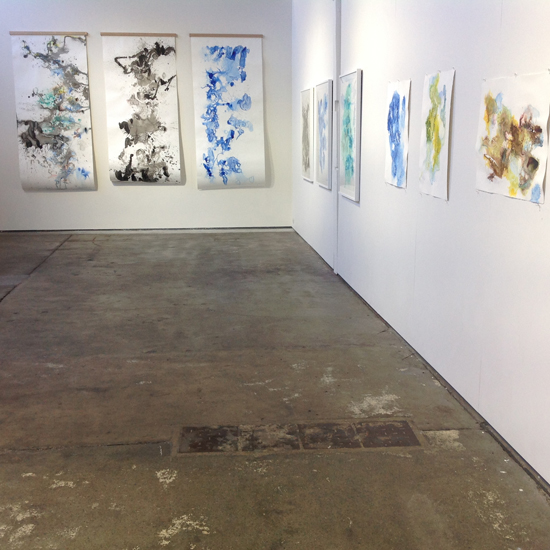Luise Guest on the forces of nature and the work of Theresa Byrnes…
Jackson Pollock once said, with his characteristic combination of romanticism and aggression, “I don’t paint nature. I am nature.” These words seem to echo, like a ghostly trace of the mid-20th century painter, through the exhibition of Theresa Byrnes’ paintings at Janet Clayton Gallery, ‘Sparrow Heart’. Byrnes is a New York-based Australian artist whose ink paintings on paper are produced in a similarly ritualised, performative manner. In a conversation at the gallery she describes her works as “shamanic” and highly deliberate. Biomorphic forms appear beneath seeping stains of colour, like highly magnified life forms seen under a microscope. In ‘Sparrow Heart Spring’ vivid green skeins of ink, from the deepest viridian to the most subtle shades of lime, curl across the surface in joyfully exuberant tendrils. ‘Sparrow Heart – Hurricane Sandy’ evokes the power of nature, resembling an aerial map of a devastated landscape, or a view of an oil spill, its merging pools of yellow and purple like a bruise. ‘Red Quill’ reveals the trace of a feather among looping swirls of pink ink. I am reminded of the paper flowers which blossom suddenly and unexpectedly when placed in a glass of water. They seemed magical to me as a child, and there is a similar magic at play here, although with a darker edge. “Maybe voodoo!” says Byrnes.
Theresa Byrnes, Sparrow Heart – Sky, ink on paper, 76 x 57 cm, image courtesy the artist
Byrnes’ technique is unusual – she cuts pieces of her own long hair, laying strands and twists over the surface of the paper so that it becomes a linear stencil as she applies layers of ink; spraying, pouring, puddling, and blowing it with fans across the surface. Twists and hanks of hair appear like shadows –almost like faint photograms – on each of the works in this show, creating forms which undulate across pools and stains of pigment. Before she begins a painting she slowly and deliberately prepares and lays out her materials. “Like setting the stage,” she says, indicating the theatrical nature of her practice. Like the works of Chinese ink painters (or, indeed, the gestural drips and skeins of paint applied by Pollock) marks that may appear spontaneous or accidental in her works are in fact highly deliberate. “There is nothing random,” says Byrnes. She likes to leave “space between the surface and my hand, and space between control and accident.” In some ways it’s all about the chemistry of paper and ink, and the transformative, alchemical processes of absorption and colour change. In other ways it is deeply primal. Byrnes uses her own hair because, she says, “Hair traces human genetics and is our rope back to the beginning of existence.” She is fascinated by the fact that the unique genetic code of any individual can be determined from one strand of hair.
Theresa Byrnes, Sparrow Heart – Hurricane Sandy, ink on paper, 57 x 76 cm, image courtesy the artist
It is not surprising that Byrnes finds this notion compelling. At the age of 17 she was diagnosed with a rare degenerative disease, Friedrich’s Ataxia, a genetically inherited condition. But Byrnes is not one to allow biology or illness to defeat her. When the progressive damage to her nervous system forced her to use a wheelchair she took up bodybuilding and Kundalini yoga. She uses her physical strength and immense determination in her performance works, and will end her Sydney exhibition with a performance at the gallery. Byrnes describes her highly physical performance works as “a very natural progression from the performative aspect of painting.” In one performance in New York, Measure of Man, her outstretched body was mounted on a large rotating disk. As she spun, black ink pumped through her hair and around her body, dripping onto a canvas below her, creating paintings.
The connection with mid-20th century action painters – and with Hans Namuth’s famous film of Pollock painting on glass – has been noted by others. Anne Marsh has described the way in which Byrnes “creates ritual-like events that involve the body as the active agent of painting.” Byrnes herself has said that she sees painting as akin to worship, as a form of communication with the divine. In this she is working in a similar way to Beijing-based ink painter, installation artist and performance artist Bingyi, albeit from within quite a different tradition. The parallels are there, however, in the way that each artist is fascinated by the chemistry of painting; in the performative discipline and ritual they apply to it; and in the sheer demanding physicality of their works. Bingyi describes her work in an intensely spiritual manner. “It’s the universe working through me,” she has said, “and sometimes it’s that space between human hand and God’s hand.” She defines her massive ink paintings as “a search for the sublime.” Similarly, Theresa Byrnes enters a transcendent state whilst enacting her paintings. Her dramatic and highly ritualised performance works leave paintings behind them as traces. Carolee Schneeman, herself no stranger to transgressive feminist performance, has described her work thus: “Covered in viscous shining paint, drenched with colour, Theresa Byrnes’ body becomes the agency of a visual, spatial transformation—marking, splattering, stroking surrounding surfaces. The effects are fierce and luscious, extending the radical marks of Kline, Pollock, and the dimensional implications of Abstract Expressionism.” It’s no surprise, either, that Byrnes admires Helen Frankenthaler, whom she has described as that singular female painter “in a sea of men.” In a review of a London exhibition of Frankenthaler’s works, Byrnes wrote, “As they spattered, daubed and stroked – she bled.” Byrnes’ work is about her bodily experience as a woman.
Theresa Byrnes, Sparrow Heart installation view, image courtesy Janet Clayton Gallery
The performative element in her paintings is especially evident in the three large (almost 2.5 metre) works hanging like Chinese scrolls at one end of the gallery. They document perhaps the biggest challenge of her life thus far, the moments before and after she discovered that at the age of 45 she was going to have a child. ‘Before I knew’ is all vivid colour and gently undulating swirls of ink. ‘What am I going to do’ is manic; with frantic splashes of black ink and the memory of jagged anxious gestures. The third, ‘Now and Forever’ is the vivid blue of a cyanotype, alluding to Byrnes’ interest in the origins of photography in chromatography. It reminds me of Yves Klein and his 1960s painting/performance works in which naked female bodies became implements to apply intense blue pigment. Byrnes is fully aware of the history of performative works, a genre in which she has become a new protagonist. There is an older tradition here, however. Just as Pollock was entranced by the ritual elements of Native American sand painting, Byrnes has spent time in Arnhem Land and worked with indigenous artists there. Sacred performances through which spirit beings are communicated with are at the core of her conceptual intentions in both her painting and performance practice, which are utterly interconnected.
Byrnes entered the gallery for the opening of her exhibition with her baby son, whom she named Sparrow, sleeping across her lap. Painfully honest, revealing of self, Sparrow Heart records her life’s journey, and it is a compelling one. She has said, “My whole life has been an experiment…a performance almost. And I’m sharing the experiment of how I’ve lived.”
‘Sparrow Heart’ continues at Janet Clayton Gallery, 2 Danks Street, until July 12. The artist will perform at the gallery on Saturday 28 June. Performance starts at 5.45pm sharp. Gallery doors will close at this time for the 15 minute duration of the performance. Exhibition continues until July 12.




Looks great … wish I could see the show but I’m in Coffs Harbour
bugger!